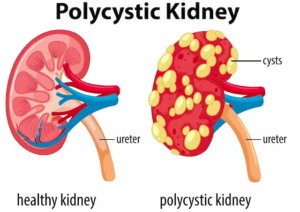Common Kidney Disorders and Treatments
Overview:
Kidney disorders and disease result in complications with blood filtration and water reabsorption and can be fatal. People are at a greater risk if they have diabetes or high blood pressure (NIDDK). The kidneys are a vital organ to the human body and kidney disorders and diseases not only effect the kidney but cause issues with the downstream urinary tract and can lead to heart disease to name a few. There are countless disorders/diseases associated with the kidney, in this section I plan on focusing on two that are commonly inherited disorders that disrupt proper renal development.
Alport Syndrome:
Also commonly known as hereditary nephritis a group of inherited disorders that effect the basement membrane of the kidney, eyes, and cochlea. Specifically, it involves the lamellation and splitting of the glomerular basement membrane. Alport syndrome is X-linked, and is inherited in this pattern in 80% of cases, and arises from mutations in genes encoding alpha-3, alpha-4, and alpha-5 of type 4 collagen (COL4A3, COL4A4, COL4A5). It effects 1 in 50,000 newborns and males are the ones that predominantly effected.
The prevalence of the three most common genetic forms of Alport syndrome are as follows.
- 85% of cases are X-linked and caused by mutations in the COL4A5 gene.
- 10-15% of cases are autosomal recessive and are due to mutations in the COL4A3 or COL4A4 genes
- Very few/rare cases are are autosomal dominant and are due to mutations in the COL4A3 or COL4A4 genes
Currently there is also no curative treatment for Alport syndrome, however the main focus of treatments is to limit the progression of kidney disease and proteinuria. options for this include angiotensin-converting enzyme inhibitors (ACE inhibitors) which reduces proteinuria, mineralocorticoid receptor blockers, and more importantly there are multiple current clinical trials going on to develop new drug therapies.
Unfortunately, while these treatments may delay the onset of kidney disease, most people affected by this disorder will ultimately require dialysis or a kidney transplant.
Research Models for Alport Syndrome:
Mouse:
There are quite of few mouse models that have been developed to study Alport syndrome. One in particular stands out. A COL4A3 knockout mouse was developed in 1996 to study the autosomal form of Alport syndrome (Cosgrove et al., 1996). This group found that knocking out the COL4A3 gene using gene targeting technology efficiently recapitulates what is seen with the human disease, where mice develop a progressive glomerulonephritis with microhematuria and proteinuria followed by a form of end-stage renal disease (ESRD) at 14 weeks of age.
More recently, a mouse model for X-linked Alport syndrome was generated using the CRISPR-Cas9 system to create Col4a5 mutant mice harboring a nonsense mutation of exon 21 (c. 1411 C>T, p. R471X) of Col4a5 (Hashikami et al., 2019).
Zebrafish:
While there are already mouse models to study all forms of alport syndrome, I think it would be very interesting to design a zebrafish model to study this kidney disorder. It would be very easy to design a knockout of any of the genes that cause Alport syndrome (COL4A3, COL4A4, COL4A5) in zebrafish. In these zebrafish models one would be able to monitor and study how these mutations effect development of the kidney (ie the basement membrane, etc..). Also they could be used to study new drug therapies and treatments in a system where the kidney can easily be imaged and visualized in vivo.

Autosomal-dominant Polycystic Kidney Disease (ADPKD):
Autosomal-dominant polycystic kidney disease (ADPKD) is the most common genetically inherited kidney disorder and affects 1 in every 400-1000 people. Researchers have found that it is caused by genetic changes in the polycystin 1 or PKD1 (most common) or PKD2 genes. The PKD1 protein plays an important role for the maintenance of renal epithelium organization and differentiation (NIDDK).
People with ADPKD have complications with many other systems in the body, such as the vascular system (blood clots, abnormal heart valves), digestive system (liver and pancreatic cysts), urinary tract (UTIs and kidney stones), reproductive system (preeclampsia) (NIDDK).
There is a current up to date treatment for autosomal dominant polycystic kidney disease (ADPKD) called Jynarque also known as tolvaptan.
There is a huge group called the Polycystic Kidney Disease-Research Resource Consortium (RRC) which dedicates their time to accelerating discovery in the realm of polycystic kidney disease.
Research Models for ADPKD:
Zebrafish
There are already current zebrafish models used to study ADPKD. One group used the morpholino approach to knockdown polycystin 2 (pkd2) in zebrafish embryos and saw that knockdown induces kidney cysts, hydrocephalus, left/right asymmetry defects, and strong dorsal axis curvature. Additionally, this group used this model to identify the specific role that the polycystin proteins have in order to determine potential therapeutic targets for ADPKD targets (Le Corre et al., 2014).
Overall, there are many other kidney disorder that can be modeled in the zebrafish system in order to improve understanding of developmental processes and design therapeutic targets.
